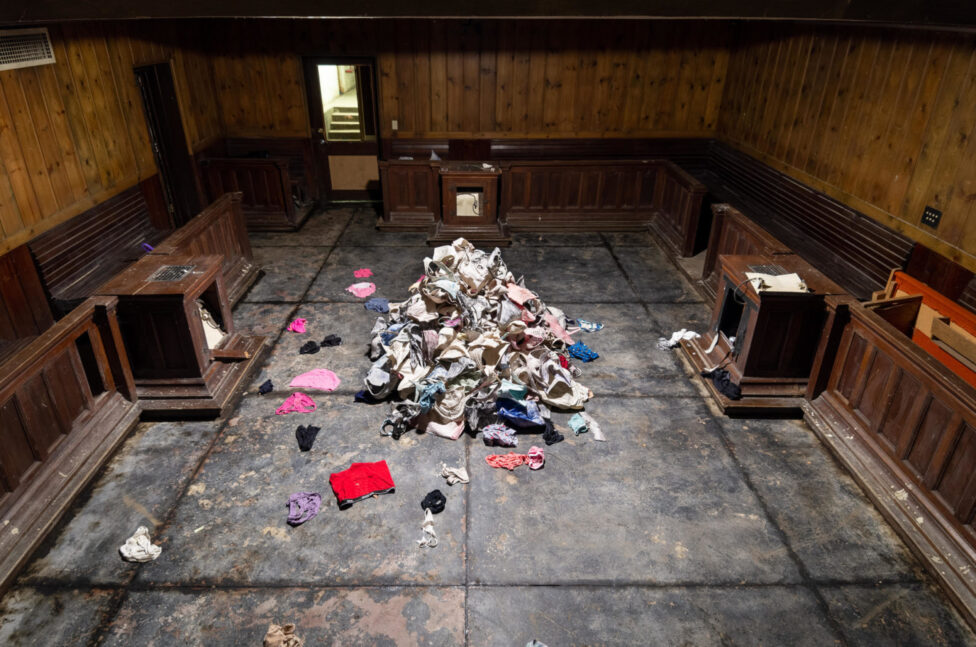Phoebe Ballard: Okay wait, and then the part of your thesis that was with Olly?
Kaitlin Fox: That was a whole other component. I’ll just say this. I was working with Olly Greer; they are an MFA studio artist at the University of Illinois. I went to one of their shows and I saw they had made all these ceramic underwear and hung them from the ceiling for one of their studio critiques. I didn’t know Olly but I loved the underwear hanging. I felt like it would tie in with the kind of sexual violence I was looking at. I was kind of taking on a female perspective but really was looking at the power dynamic between sexual violence not being specific to any gender. And that was really important to Olly because Olly is queer and we had this whole other production part of it where we started collecting all this underwear. Olly’s work is very communal and that was a new way for me to work where I’m asking people to send me all this underwear. There’s a different kind of participation in the dance without people having to dance at all or know anything about the project. Will you send me underwear is pretty easy.
PB: Yes, so whoever you follow on Instagram, will you send me underwear?
KF: Pretty much, yes. And it activates that person, and you end up building community through that. So we ended up with 475 pairs of underwear and it was really moving. People dropped it off, they sent it in from all over the place. So when the pandemic hit, we were like, great no dance. But we do have this thing. We should keep going with it, mostly to honor the people that took the time to send us stuff in the mail. That was really important to us. We felt this haunting feeling, people would send in their underwear and be like “this is the underwear from my wedding night, it was a horrible marriage, I’ve never known what to do with these, it seems like you’ll find a purpose for them, I’m really glad to be getting rid of them in this way.” Because people don’t throw underwear out, really.
PB: I sent underwear in to you, I remember seeing it and thinking “oh, Kaitlin is asking for underwear, Kaitlin’s my friend of course I’ll send her underwear.” Which is weird in itself now that I think about it (laughter), but you also posted, “I promise we’ll take care of them.” That is such a tender exchange, such an intimate thing. We never connected face to face about the underwear but I’m sending it to you and I trust that you are going to take care of them.
KF: Yeah, it is such a personal thing. What kind of underwear, how long they keep it for. We got a lot of stained underwear, like this is what I’ve worn since I was 15. So things that were real significant to people and we felt we had a responsibility to take care of them. And to know that we had conversations about whether or not we should buy underwear, because for the structure we were trying to make, it needed to be a certain kind of density or size to look significant in this giant stock pavilion. Because once you put it in a stock pavilion 50ft away from the audience it does look quite small when it hangs above.
PB: So school is cancelled, no dance thesis, but we have this underwear, Olly is here, what can we do with this. So you plastered it, is that what happened?
KF: Yes. So we would do wheat paste and dunk and coat the underwear in there, because it would be expensive to create ceramics and put them in the kiln. We were very much in the underwear, smearing over the crotch, all over, putting balloons in and hanging on clotheslines to dry. There was a lot of interaction with the underwear. It’s not like they sat in a bag until the show and they were installed by a stagehand. Olly and I did everything. I was house-sitting on a property that had a barn and I thought we should install and do a photo shoot of them there. We were trying to continue the idea of suspending them. And then Olly called me one day, not having anything to do with this, and was like, “let’s go frat hunting,” and I was like “I have no idea what that means but, fuck it I’ll get in the truck” (laughter). And on this street we found this giant, 56 room fraternity house that was boarded up. We tried one of the doors, it was open. We found ourselves in this dark basement, absolutely terrified, because it was clear that people had been in there, there was spray paint all over the wall and beer cans all over. We felt very vulnerable. And then we were like, let’s put the underwear in here. And then it shifted the research. It was a more direct statement against transphobia, homophobia, these structures of power that were very rooted in white supremacy. Because that’s what all fraternities are, elite social clubs for cishet white men.
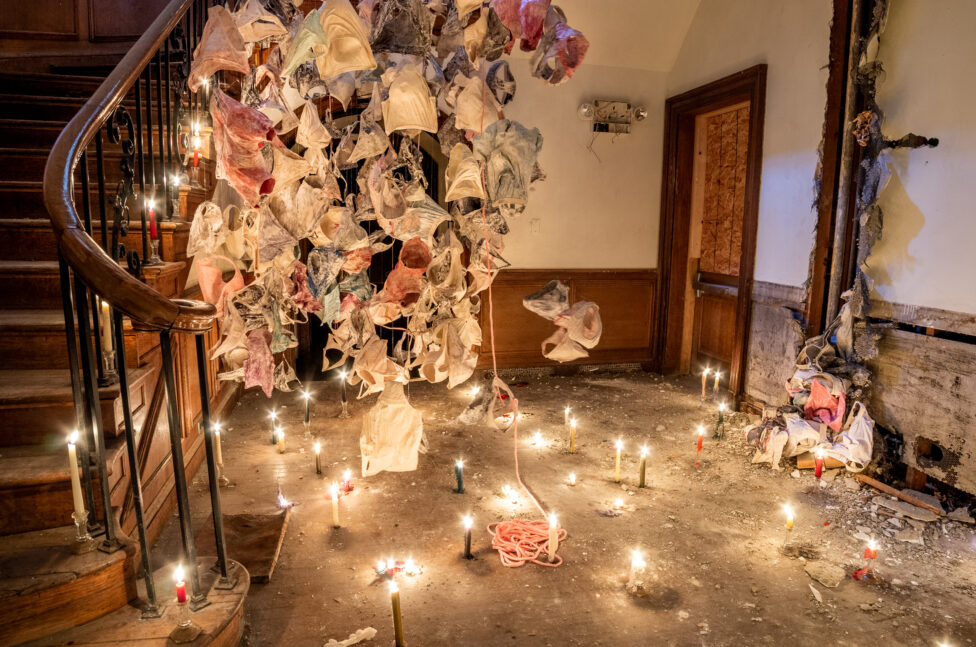
Photo by Mitchell Oliver
ID: A dilapidated room ceremoniously transformed by a mountain of underwear suspended from the ceiling. There was also underwear stuffed into the wall and lit candles carefully placed on the floor as well as the stairway.
PB: The underwear should live here.
KF: So then that did feel like my thesis. We brought Mitchell Oliver, a new media artist who is a longtime friend and collaborator, in because we need someone to document this stuff. I hate that it has to be this way, but it was good to have a white male in there; Olly and I both felt a little bit safer. My nervous system that whole time was just on the fritz, very wired, very electric. Mitch was nice to have there.
PB: As a safe presence.
KF: Yes, he’s very chill. I trust if something had happened it would have been handled very safely and calmly because he was there. Anyway, he came in and started documenting it. I was still trying to find the movement inside, trying to work with a material-based practice. My whole practice had shifted into this working with objects, not people, and the only control I had over movement was how we put the underwear into a pile: are we throwing it, are we dropping it, are we placing it, are we kicking it into place, are we dragging it? Those all have different qualities that add movement into a still shot—I’m not used to working like that at all.
PB: Yes, with bodies and people.
KF: And constantly moving. So to just have this thing that was stationary, I started making scores for each room we would work in. So the first room, we started in the basement, we started in the chapter room downstairs. You’re in these rooms that so much violence, power, and aggression have happened in these spaces, and just fear. And this fraternity, we didn’t know, had a bad reputation. The house did not give off warm vibes. So we would make a pile right in the middle, almost an altar of sacrifice to the platform where the president and vice president would sit. So we made the pile, we’d stack them, and the underwear that wasn’t dipped we’d just drop them. We’d move through the space with our eyes closed. We’d place them with the full palm and when it was ready to let go, we’d let go and wander with our eyes closed. So it was just trying to find that stuff inside the installation that no one’s going to see.
PB: But it does inform the creation and the layout…
KF: And our relationship to the underwear. We became very attached to the underwear. I was very upset after the last day we did our install, which ended up being a chandelier dropping down from the third floor in the grand staircase. When you open the front door it’s the first thing you see. And we got caught that day. Someone came in and was like, “what are you doing here? If I see you here again I’m going to call the cops.” We got out of there that day in a very different way than we had been. We exited the space and left these underwear hanging; they were stuffed in the wall, candles all around. I was so attached to them that I felt like we abandoned them. I was worried about their safety, that they would be energetically penetrated by whoever was coming through there. That night Olly and I were in the car until five in the morning just talking about it. I had never felt that way. And I think I would have felt that way had the dance happened, like that’s the closing moment… Did I take care of everybody the right way, did I do a good job, was that the right decision? All that kind of stuff. It was a similar feeling of, now what. It’s out of my hands now.
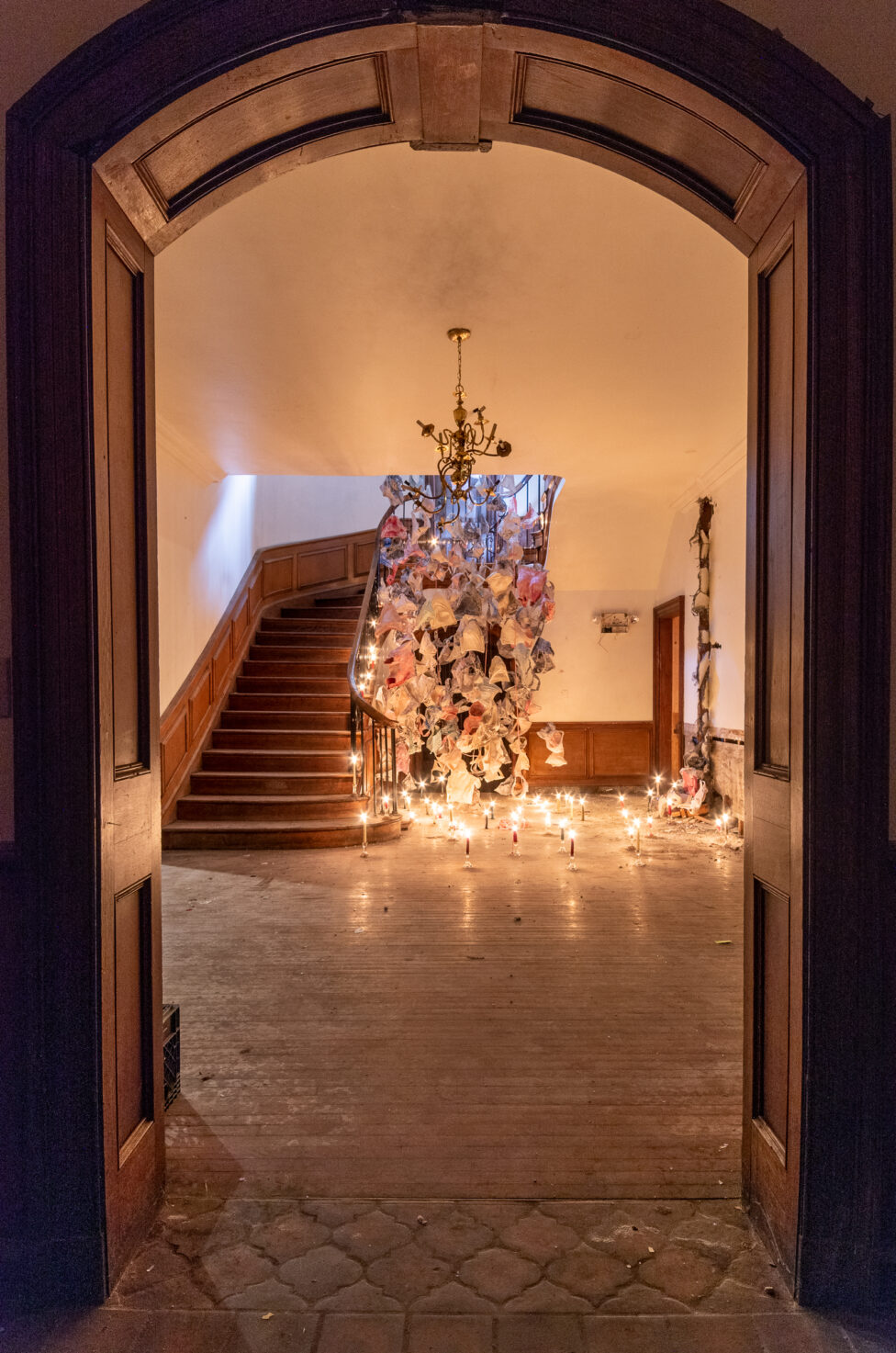
Photo by Mitchell Oliver.
ID: Seen from the front door entrance, this vertical shot shows the “underwear chandelier” hung from the third story banister.
PB: And it’s almost like it was yanked out from under you there, too. The movement, the performance aspect yanked out from underneath you, with the aggressive presence coming in and saying you’re done, that runs parallel too.
KF: We had a ritual. We’d go in at night, when no one would really be seeing us. Olly and I would set up; if Mitchell came, he’d come a little later. We’d sing songs, light all these candles, step back, look at the work, blow them all out, clean it all up, we really made it a workspace. And there was closure each night. The last thing we did was the chandelier and we knew that would stay, but for it to be interrupted in that sense was really hard. On the last day we had brought the jump ropes in. We were double dutching when this guy walked in, pitch dark, and this chandelier of underwear with 150 tapered candles. It was definitely a fire hazard whatever, and us just double dutching. The guy was like “what are you doing” and Olly was like “playing games and making art!”
PB: And he was like none of that here!
KF: Exactly, right! We did go back one night and I saw that they had cut them down because you couldn’t access the front or the first floor without walking through them, which was cool because someone would have had to interact with them. That was satisfying. Then they tore the house down. It’s bulldozed.
PB: Underwear included.
KF: Underwear included. And the demo people, we asked them if they had seen underwear in there, and they were like “yeah, there was underwear all over the place.” And that was a relief— that it was there and it was felt and it was experienced because it was really overwhelming just the three of us doing this in secrecy. That’s kind of what I’m doing right now. I’m just being more secretive with stuff. I don’t need to prove to anyone that I’m doing anything or working on it or making a product.
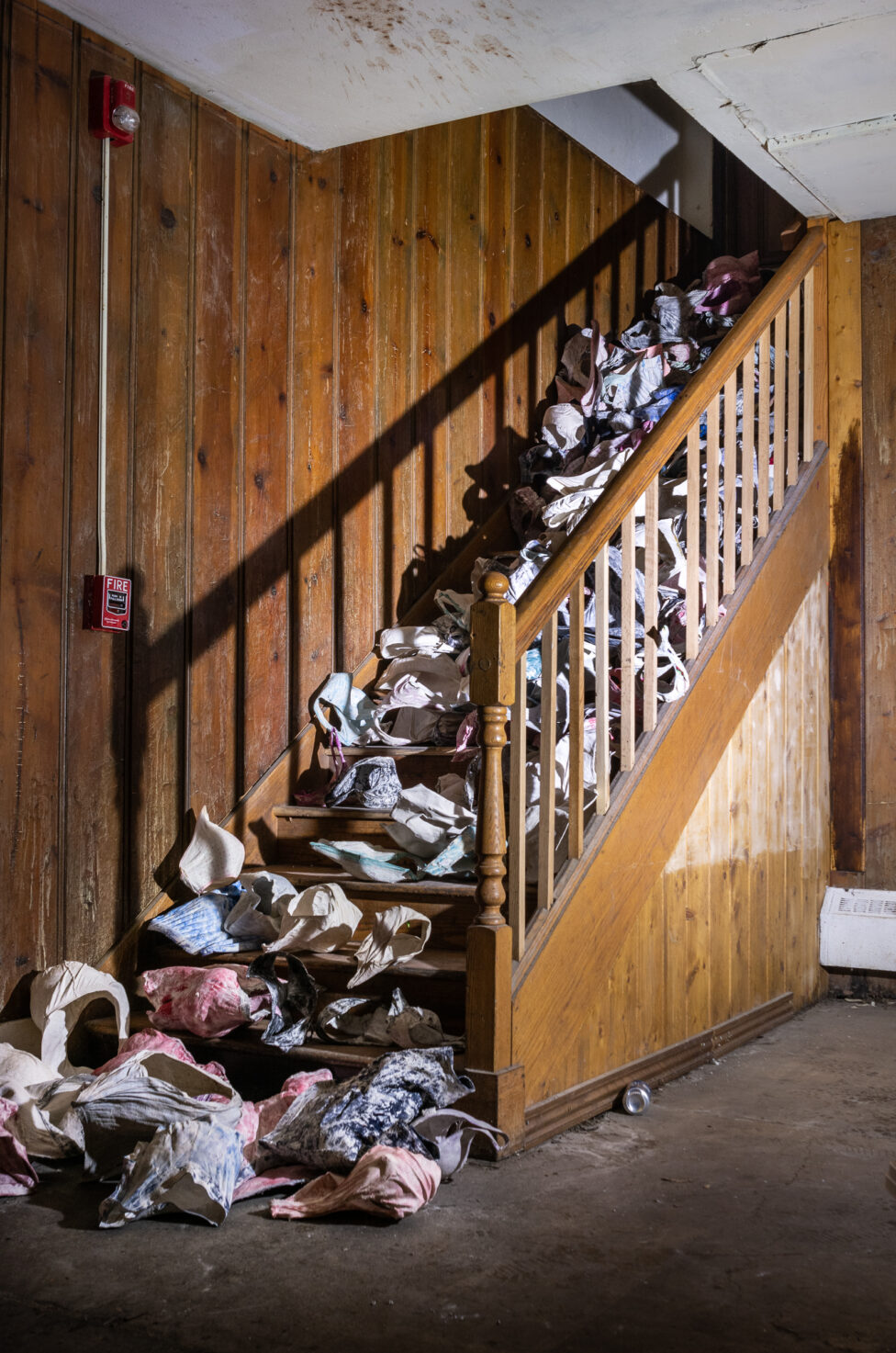
Photo by Mitchell Oliver
ID: A wooden stairwell flooded by underwear
PB: I’m just doing what I need to do.
KF: I’m just doing whatever I want to do.
PB: And following intuition and pleasure.
KF: And the fraternity was very much that. It reminded me of the importance of true collaboration where you’re working out your ideas, working with someone from a different medium. I really did learn a lot about how to still get what you need within your framework of thinking while also adhering to the dynamics of the project you’re working in. Being like, I need to bring in a score to set this. And Mitchell being very particular about how he thinks it should be on the internet. That was helpful, but then also just play. I realized in my thesis I wasn’t playing anymore. I was so concerned with how it was going that I lost the spontaneity inside it. No playfulness or spontaneity, I became too rigid inside of it.
PB: Right.
KF: That’s why now I’m like, no rules.
PB: No rules ever again.
KF: No thanks. Yeah, the underwear. We want to keep going with it, so that does feel like an extension of something that was cancelled or erased or mourned. I am really thankful that we all think it is worthy of more attention. And it’s nice to work on something for a long time.
PB: It’s like the phoenix rising from the ashes.
KF: It’s kind of nice that it’s not dance. That’s how I’m thinking about things now; where is the physical body inside object based work? It makes me feel things in a more humane way. It makes me have a greater compassion for things. It’s never what you think or expect it to be or presume how it’s functioning. It’s really a living breathing machine that changes and morphs over time. To remind myself to be less precious about it, to just name what it is, will help create this larger body of work.
PB: Instead of an insular approach.
KF: Yeah, things are just not that separate.
PB: Everything is interdependent.
KF: Everything. Everything.
PB: You graduated with this degree that would theoretically open doors for you but then you’re walking into this space where everything is shut down.
KF: No opportunities in terms of consistent income. There’s nothing. So you have to be on your own, you have to take time to think about those things, because I literally have nothing else to do.
PB: Except think about them.
KF: Do you think that that’s true for you? Are you feeling a moment to reconsider how and why with what you’ve chosen?
PB: Definitely. Back in March it felt like panic mode—how do I keep doing this? I have to keep doing this, because it’s tied to financial stability. But then that brings into question, the reason I’m doing this isn’t for financial stability, so when does it become a job, when does it become my artistic practice and my job?
KF: Yes, that too. Now that I’m done with school there’s no prospect for a job really. I’ve had to convince myself that the day-dreaming, the rolling on my floor, or when I feel like I’m doing nothing, that that is work. And it just looks so different than what we are conditioned to consider work, especially when it’s just for yourself, by yourself, when you don’t have any financial strings. I don’t have a grant or performance space, so no one is demanding that I show up for that stuff. I think giving myself permission to rename my pleasure hobby, which is dance, as my job. Reading a book is my job. Doing yoga is part of my job. Meditating needs to be part of work. I think that is really helping me to feel more grounded and really take myself seriously and my dancing and my whatever choreography. I would just reframe the language around this, so it’s not “oh do I want to go to class today” but “oh no I have to go to class today because it’s part of my job.” It helps. I have to take a fucking bath today…
PB: Because it’s part of my job…
KF: Because it’s part of my job! Because my body is my job.
PB: And putting those structures on yourself. No one is telling me this is my job, I have to tell myself this is my job.
KF: Right. And I have to be the one to validate that because I’m not going to get that external validation. I realized how dependent I was on creating my self-worth through the validation of others, whether it was in class, getting hired for a project, any of those ego things that make you feel like you’re doing a good job—that’s all gone away now. You have to be the validating source for yourself and that is really hard.
PB: That was one of the things I realized when I left school, having no source of external validation, when moving or looking for a job, not having any sort of timeline to follow or professor to tell you “that’s the right thing to do.” Not even looking for a pat on the back, just a ”you’re doing the right thing, you’re moving in the right direction’. You have to become your own motivator.
KF: It’s trusting your instinct, knowing you don’t think this feels good, it doesn’t feel right for you, it isn’t in your best interest to be doing that. That thinking is quite utopic, amidst this pandemic, this social unrest in this country, and this divide. Those things actually feel more important for me to be attuned to rather than continue playing by the rules, doing what people think I should be doing.
PB: Everyone’s survival of things looks different. I think that is what it boils down to.
KF: Very much so. And to not be judgmental about that. That is also really hard in this form where, historically, there has been so much judgment inside of certain techniques and inside the hierarchy of dance. You’re auditioning for stuff, you’re being selected for something, there is always, “will you accept me.” And when you’re on your own and everyone is on their own right now, what does that look like then?
PB: How do you keep yourself going?
KF: How do you belong without being necessarily accepted?
PB: That’s a good question (laughter).
KF: (laughter). I read a book when I was finishing my thesis, which was such a haul once the pandemic hit. We had spring break so we didn’t have any work. Then we weren’t coming back to school, so I don’t really want to write this thesis after having nothing, after having no show. So I bought this book on belonging, because everyone felt so lost, and I’m sure they still do, I know I still do. It’s just a whirlwind. The only thing we have to just really ground down in at the end of the day is the body. Take away all the material objects, take away all these external structures, employment situations, academic institutions, the government, or the question of whether the stimulus check is coming or not. You just have your body to be like, well, I am here (laughter). Let’s go.
PB: And that’s all I know for certain.
KF: That is the only thing you can know for certain!
PB: Speaking of your thesis, before, before, before all this, what was it going to be?
KF: Well, now I know it was probably going to be a large event that fell flat (laughter). I’m kidding (laughter). I had done an invited dress rehearsal, I was thinking it was in a really good place, I was finally putting all these structures together. It was a really large cast. It was three solos, and a group dance for seven. I was performing in it and building all this original sound in a stock pavilion so there were all these aspects that were very foreign. I had never worked with a large cast. Anyway, I showed it and the feedback was that it fell flat. I had a major breakdown. You think you made the work and then someone is like no you didn’t. Well, my instincts are way off then if this is not flying with anybody.
So I went home and talked with Neal, the sound designer. He reminded me that sound has to have dynamics. I thought about Tere O’Connor’s advice about what you are shining light on right now or what you are dimming. That’s what I needed to do. I got all these ideas of how I’m going to go back in and reshape it. We had one rehearsal where I was like “that’s exactly what I needed to do.” And then it was like, no more. So I was just about to get back to the peak and climb over, just to have that gone again. I know I didn’t fail, still I felt like such a failure, to have no control over the situation and to see your work disappear before your eyes, instantly. Can I set it as a solo and reimagine it? Yes. But that old version has to be totally done and gone.
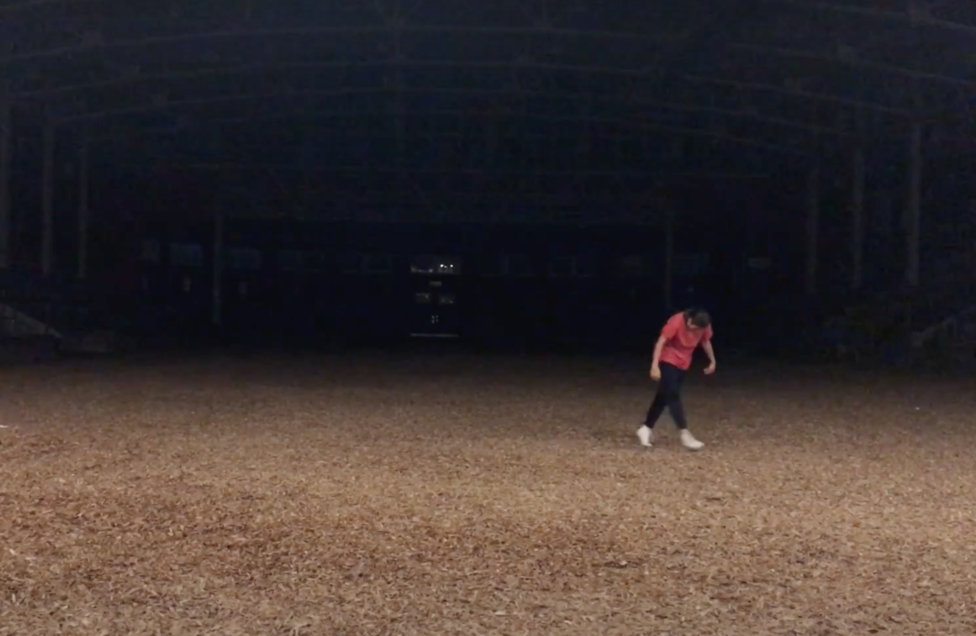
Photo by Kaitlin Fox.
ID: Rehearsing in the performance space, Jessica Ziegler, a soloist in the thesis, stumbles across the wood chip floor of the Stock Pavilion at UIUC.
PB: After everything was shut down, dancemakers in different cities were still there; a lot of times, dancers were still there. Or if they were going to be presented, the presenter might present them next season. But because your timeline is tied to academia, there’s nothing.
KF: I’m graduating, I’m leaving, the people in the cast are leaving…
PB: The space isn’t there, the next MFA class needs to do their thing, so bringing you back is an impossibility.
Do you feel like you got any closure or finality with the work itself? In the sense where you were ready to move on from it, or do you think it’s going to be this thing that you need to complete at some point? Or is it taking the higher road—“I’m going to learn from this experience?”
KF: I think it’s leaning a little more towards the last one. What I was looking at through that research was not only the aesthetics of feeling haunted, but that psychology, where that places you when it’s so tied to the past. And dance is such a present form, so I think it’s alive in me in that way—the material, and the memories of it, and the smell of the woodchips [used in the work]. But I haven’t really been doing anything directly related to that. Would it be cool to work with a large cast again? Yes. Would I do it differently? Yes. But now’s not the time for that, now I’m more interested in making a solo. Which is actually how the piece started. I was like “I’ve never made a solo before, this is what I should do.”
PB: And then you were like, “I’ve never made a large group work before, this is what I should do.”
KF: (laughter) Exactly. At my audition we just did jump roping. It was a really nice way to see people differently. See them take risk in a different way, see them be vulnerable, see them do something they haven’t done before, maybe ever or at least in an audition setting. No, we’re not going to learn choreography. I just want to see you try and go through these two ropes. And everyone was cheering each other on and I got on a high from that. I was just thinking this could be really fun, and it felt like a lot of people gravitated towards that and liked it.
PB: And came together through it.
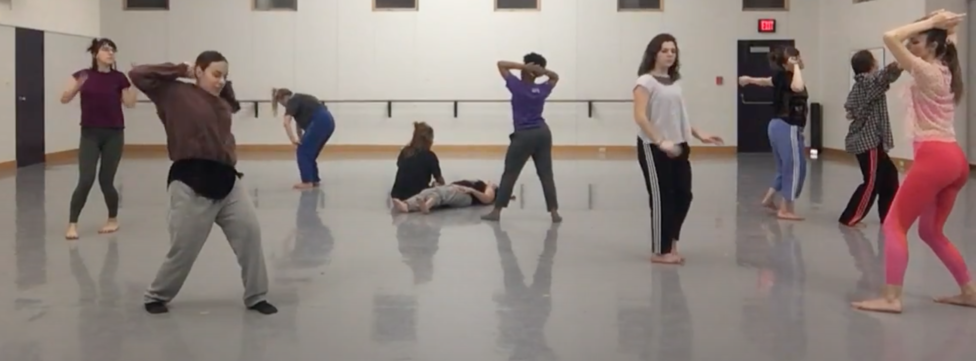
Photo by Kaitlin Fox.
ID: A group of ten women rehearse for Kaitlin Fox’s thesis, rein in minor mourning, in the dance studios at University of Illinois. (Pictured from left to right Sarah Marks Mininsohn, Yaritza Fletcher, Taylor Adams, Kaitlin Fox, Caitlin Botcher, Alex Kinard, Jessica Ziegler, Lindsey Jennings, Brianna Undzis, Rachel Rizzuto).
KF: Yes. A lot of people wrote my name down on the sheet of who they’d like to work with, people I wouldn’t have considered before. And I realized sometimes the dancer does know better than the choreographer that they are right for that material. As the choreographer, if you’re just willing to take a look at that—someone’s coming to you and saying I think I’d do well with this, I’d really like to work with you—I would like to be a person who honors that source of knowledge instead of assuming I know what I want going in and taking who I think is going to be right for ite. So, the cast expanded because of that. Every time I’ve ever started a dance I’ve been very overwhelmed thinking about what it is. I’m not making a thesis anymore, I have no show. So I have an opportunity to make whatever the fuck I want, you just have to start somewhere. So, jumping jacks? Sure. Let’s see where this goes.
PB: Right.
KF: So I am using some of the material from my thesis because I like the weight and density of it and the attack and drive of some aspects of it, which are related to things that I’m thinking about now.
PB: I wonder if this dance that was never fully actualized is going to live on in all your works from here on out.
KF: Right, it would be so cool to go back to another stock pavilion. I really liked the space I was working in. That’s a really rich component of the work that I would be willing to keep investigating. Sometimes you need to put something to bed for a little bit knowing you can wake it up later.
PB: That’s a good way of putting it.
KF: Is anything ever finitely done? No, everything has a residue. To accept that and be okay with it makes me feel like there are more possibilities for it and those will just come when they come. I don’t need to spend a bunch of energy trying to wrangle it in.
PB: To be like, now I make the dance about how my thesis would have been.
KF: (laughter) Right, right. Especially now with coronavirus I’m not interested in that kind of energy expenditure. I’m really trying to be very tranquil and do really what feels good. Because that is radical right now.
PB: I think so, too.
KF: Just, fuck it.
PB: Especially because everything is operating up here [hand gesture], you know enough about yourself to know, okay I’m not operating up there so let me move into that versus trying to amp myself up to get there.
KF: Yes. The moment is quiet, I’m going to get quiet. And that’s translating back into my work. Then I realize how important it is to still, even if you don’t know what you’re doing or you don’t know what you’re making. But for me, if I don’t know what I’m doing or I don’t know what I’m making, I stick to a practice or a process that will inevitably show me what it is. And it will reflect back out to what I’m experiencing in my pedestrian personal life, which I often think is very disconnected from my movement practice. When I go into the studio I don’t feel I just released all my feelings today. I never feel like that, but I do think that I notice in the quality of movement, there’s more tact here. I’m working really slow today. I’m working really quick. I need a lot of musicality. I need a lot of changing rhythms. That makes me realize the kind of cultural or social time and space that I am feeling and having to deal with. Because right now I’m just being very heavy and laying on the floor. For me to move slow, I just don’t do it. So I’m like, try it Kaitlin.
PB: Stick with it.
KF: My body is wanting to move slow and now I feel the benefits of that affecting my personal life. It’s allowing me to have more patience with myself and other people, which is so needed right now. Doing anything is better than nothing. If you want to stay in something, just do anything. Give yourself permission to take time.

